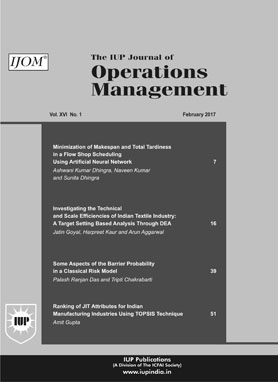
May' 23
The IUP Journal of Operations Management
Impact of Inventory Capacity Constraints on Supply Chain Dynamics: A Computer-Based Simulation Approach
The bullwhip is a well-known phenomenon in supply chain management. Whereas past research has focused on factors like supply rationing, batch-size, lead-time, etc., mainly from an analytical perspective, this paper broadens the research by specifically examining the impact of inventory constraints not only on demand (order size) but also on inventory levels and supply chain cost. The results confirm the findings of past research and bring new insights on the impact on component and compound bullwhip effect behavior across supply chain echelons by showing that inventory acts as a damper on bullwhip effect.
Building a Better Digital Maturity Model for Midsize Businesses in a Post-pandemic World
In the aftermath of the Covid-19 pandemic, numerous businesses underwent sudden and crucial changes as countries across the globe grappled with adapting to the 'new normal'. This paper explores the challenges of digital transformation that midsize businesses face and proposes a digital maturity model to navigate the fallout from the pandemic and other crisis-driven changes. The digital maturity model-the effectiveness of which is evaluated through a series of interviews and interactions with industry professionals and practitioners-is intended to function as a roadmap and a communication tool on the journey of becoming an agile business.
An Integration Approach to Total Quality Management
Quality control is a key factor for the survival and future development of any organization; it is also one of the most important factors for gaining a competitive advantage in a demanding and dynamic market. One of the basic tasks of management is to choose a combination of product quality characteristics that will be optimal for buyers. Only by successfully managing product quality characteristics, can the set goals of companies be achieved, which means achieving greater financial results in operations, and also satisfying the needs of customers. Analyzing their success and rise, the study comes to the conclusion that only those organizations that have professionally trained management teams promptly carry out all the necessary structural changes and continuously follow the wishes and needs of consumers, with an integration approach to Total Quality Management (TQM), succeed and achieve the set goals. The study is based on an analytical descriptive methodology that aims to provide relevant insights for the integration approach of TQM.